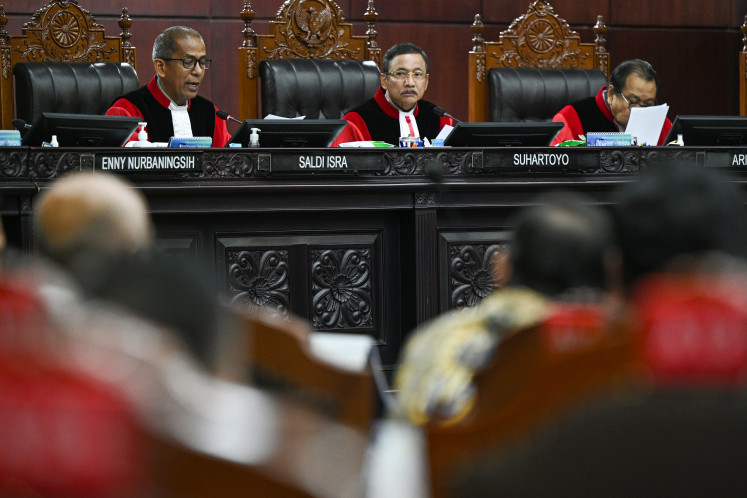Popular Reads
Top Results
Can't find what you're looking for?
View all search resultsPopular Reads
Top Results
Can't find what you're looking for?
View all search resultsPencak silat benefitting from increased popularity
Ruly Kurniawan clenched his fists, swinging his left hand to the right while keeping his feet planted on the ground during a practice session of Indonesian traditional martial art pencak silat in South Jakarta’s Jagakarsa subdistrict
Change text size
Gift Premium Articles
to Anyone
R
uly Kurniawan clenched his fists, swinging his left hand to the right while keeping his feet planted on the ground during a practice session of Indonesian traditional martial art pencak silat in South Jakarta’s Jagakarsa subdistrict.
The 15-year old took a brief time-out, then repeated his movements several times to perfect his balance.
Ten men spent Monday night performing pencak silat combinations at the H. Hasbullah Traditional Beksi School of Pencak Silat, one of the city’s oldest pencak silat schools.
“At first, it was difficult to master all of the stances. But because I have kept on practicing for two years, now I can perform 12 routines,” he said.
Ruly admitted preserving local culture was the main motivation that had driven him to take up the martial art.
Wahyudi Tejo S. shared a similar reason for enrolling at the pencak silat school.
“I’d like to develop the Betawi culture. Apart from that, I want to master pencak silat,” the 21-year old man said.
Five years of studying at the school, he said, had helped channel his fighting spirit into a positive force.
“I used to be very naughty and loved drinking. I even failed to graduate from senior high school because of my ill-tempered character. Being a Beksi fighter has helped me to leave behind those bad habits,” he said, referring to the Beksi style of pencak silat.
Muhali Yahya, the chairman of the school, said scores of people, both young and old, had registered at the school’s 27 branches across the capital.
The company has schools in Rawa Belong in West Jakarta, Pancoran in South Jakarta and Kemayoran in Central Jakarta.
Since 2005, the school in Jagakarsa has received about 150 students, 72 of whom were street children, Muhali said.
“Many young people are enthusiastic to learn the style. Therefore, we run classes for children and women in Jagakarsa,” the 43-year old man said.
Beksi, he said, was a style of martial art that originated in Tangerang, Banten, in 1828. It was introduced to Jakartans by Chinese fighter Lee Chenk Oek in the 1950s.
Muhali said that Beksi consisted of four defensive styles. “The style aims to teach how one can defend against attacks from all directions,” he said.
He said Beksi was a “hard” fighting style that required fighters to land quick and strong strikes on their rivals.
Another pencak silat style, called Si Bunder, utilizes mind reading techniques to predict an opponent’s attacks.
“Learning Si Bunder is quite difficult because it teaches fighters to read an opponent’s mind to know which side they will attack from,” said Babe Nung, a senior coach.
Si Bunder, he continued, required “never ending stance development”. “We always come up with new movements and it may take up to five years to master all 17 stances.”
Unlike the Beksi style, there are not many records chronicling Si Bunder’s history. “We do not have any schools or specific training attire. We do not classify our student fighters into beginner, intermediate or advanced. We simply practice in accordance with the necessities,” Babe said.
He said that although hundreds of students had dabbled in Si Bunder, few had chosen to pursue it to an advanced level, preferring instead to learn the basics and incorporate them into other styles.
“Most of them leave the style once they have gotten what they really need. They do not want to develop and preserve it,” he said.
The 50-year old man said he was selective in choosing his students.
“Now I have 30 pupils, all of whom are devoted to continuing to develop Si Bunder,” he said.
He holds practices four times a week in Kuningan, South Jakarta, and in Menteng Park, Central Jakarta.
For Babe, pencak silat serves not only as a means of self-protection but also as a source of personal pride and confidence. “It is possible for a fighter to quit altogether if he loses a fight simply because his pride has been damaged,” he said.
According to the City Culture and Tourism Agency, the city has about 300 traditional pencak silat styles, including Bayang Gerak Lodaya, Sabeni, Sipecut, Bandrong and Syah Bandar.
Some are recognized by the Indonesian Pencak Silat Association and the Indonesia Traditional Silat Conservers and Lovers Forum.










